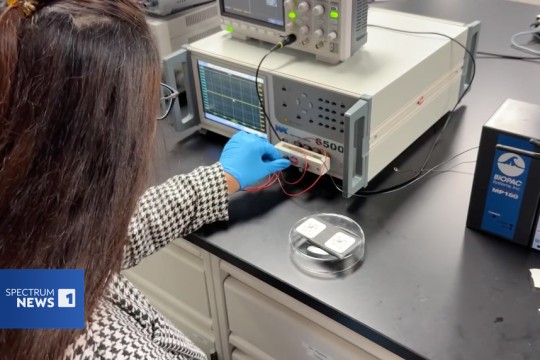RIT Scientists Use Supercomputers to ‘See’ Black Holes
Time won on Blue Waters, Ranger supercomputers; plus grant to create cyberinfrastructure
Scientists at Rochester Institute of Technology have won several grants to further extend their own supercomputer and make use of two of the fastest supercomputers in the world in their quest to “shine light” on black holes.
Since light cannot escape from the surface of a black hole, scientists rely upon computer algorithms to study the massive dark objects. Researchers in the Center for Computational Relativity and Gravitation at RIT are using supercomputers on campus and across the country to simulate with mathematics and computer graphics what cannot be seen directly.
“It is a thrilling time to study black holes,” says Manuela Campanelli, center director. “We’re nearing the point where our calculations will be used to test out one of the last unexplored aspects of Einstein’s General Theory of Relativity, possibly confirming that it properly describes the strongest gravitational fields in the universe.”
RIT mathematics professors Campanelli, Carlos Lousto, Yosef Zlochower and Joshua Faber and computer science professor Hans-Peter Bischof study the evolution of black holes and other objects using large-scale supercomputers. Their computer lab hosts “NewHorizons,” a cluster consisting of 85 nodes with four processors each, connected via an Infiniband network that passes data at 10-gigabyte-per-second speeds.
Three National Science Foundation awards have brought the center’s external funding total up to $2.9 million in the past three years. The awards—plus time won on a top supercomputer—will dramatically enhance the team’s access to the most sophisticated computer power in the world:
“Computers are only going to get bigger and faster over the coming years,” says Campanelli, “and with these grants and allocations, RIT’s numerical relativity group should stay at the forefront of scientific computation for years to come.”
Rochester Institute of Technology is internationally recognized for academic leadership in computing, engineering, imaging technology, and fine and applied arts, in addition to unparalleled support services for students with hearing loss. Nearly 16,450 full- and part-time students are enrolled in more than 200 career-oriented and professional programs at RIT, and its cooperative education program is one of the oldest and largest in the nation.
For two decades, U.S. News & World Report has ranked RIT among the nation’s leading comprehensive universities. RIT is featured in The Princeton Review’s 2009 edition of The Best 368 Colleges and in Barron’s Best Buys in Education. The Chronicle of Higher Education recognizes RIT as a “Great College to Work For.”












